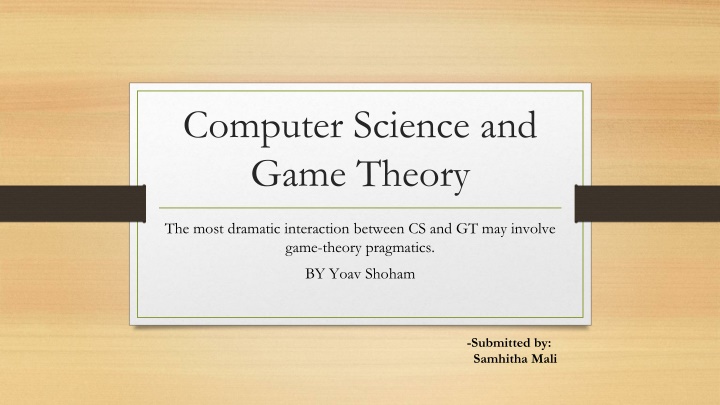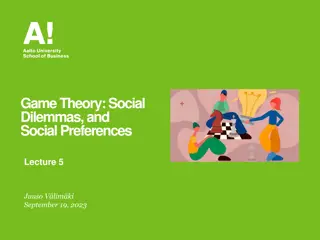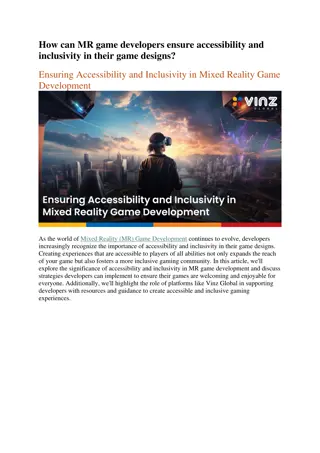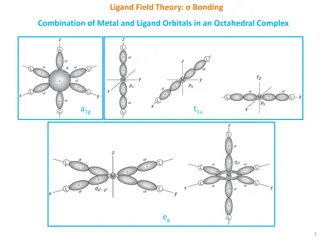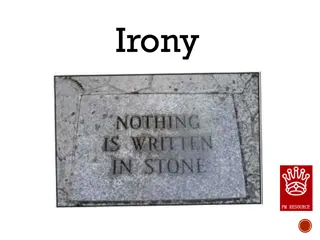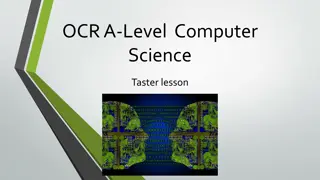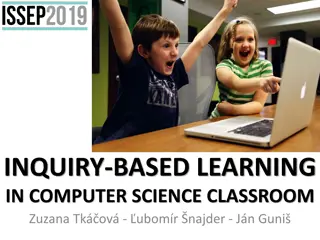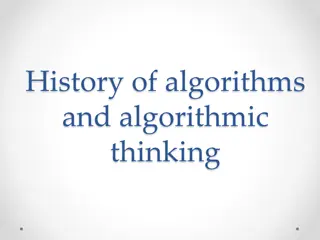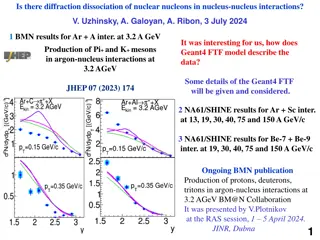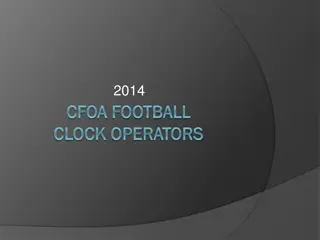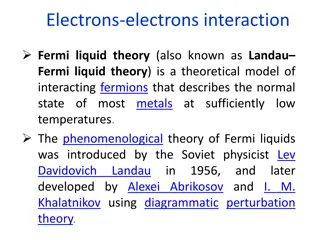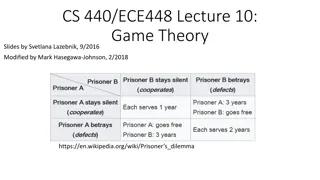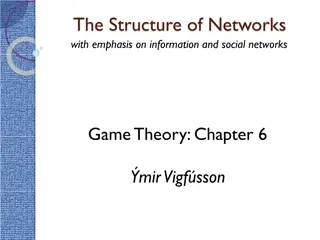Dramatic Interactions Between Computer Science and Game Theory
Fascinating relationship between Computer Science and Game Theory, delving into the principles of Game Theory and its impact on various disciplines. From Nash equilibriums to multiagent learning, discover how these fields intersect and shape modern technologies and decision-making processes. Uncover insights from notable figures like John von Neumann, and delve into the practical applications of Game Theory in diverse areas such as AI, networking, and economics.
Download Presentation

Please find below an Image/Link to download the presentation.
The content on the website is provided AS IS for your information and personal use only. It may not be sold, licensed, or shared on other websites without obtaining consent from the author.If you encounter any issues during the download, it is possible that the publisher has removed the file from their server.
You are allowed to download the files provided on this website for personal or commercial use, subject to the condition that they are used lawfully. All files are the property of their respective owners.
The content on the website is provided AS IS for your information and personal use only. It may not be sold, licensed, or shared on other websites without obtaining consent from the author.
E N D
Presentation Transcript
Computer Science and Game Theory The most dramatic interaction between CS and GT may involve game-theory pragmatics. BY Yoav Shoham -Submitted by: Samhitha Mali
Background of the content What is Game Theory ? Def: It is a Branch of applied mathematics that provides tools for analyzing situations in which parties, called players make decisions that are interdependent. This interdependence causes each player to consider the other player s possible decisions or strategy, in formulating the strategy. - John von Neumann (Father of Modern day GT & CS) It is the optimal decision making in social situations among competing players
Background of the content Key terms discussed in the content Nash equilibrium Dominant Strategy Prisoner s dilemma Zero sum game
Introduction of the Content Game theory into Political science, Biology, Economics and others Presence of Game theory in Computer science Presence in AI, E-commerce, Networking and others 2 Reasons for its presence Application Pull Technology Push
Introduction of the Content Two things that has been briefed in the content Identify the main area of interaction between computer science and game theory Point to where the most interesting interaction yet may lie Providing a balanced set of initial pointers into the different subareas Other relevant surveys of CS-GT interactions Subjective, Interaction between Disciplines
Lessons from Kalai (1995) A game theorist Interaction between Game theory, Operation research and computer science. Areas that has been pointed out 1. Graphs in games 2. The complexity of solving a game 3. Multiperson operations research 4. The complexity of playing a game 5. Modeling bounded rationality
CS & GT Interactions today (2008) a. Compact game representations b. Complexity of, and algorithms for, computing solution concepts c. Algorithmic aspects of mechanism design d. Game-theoretic analysis inspired by specific applications e. Multiagent learning f. Logics of knowledge and belief, and other logical aspects of games
Interesting perspective of a non-computer scientist, is the comparison with current CS-GT interaction both matches and mis-matches 1. Graphs in games 2. The complexity of solving a game 3. Multiperson operations research 4. The complexity of playing a game 5. Modeling bounded rationality e. Multiagent learning f. Logics of knowledge and belief, and other logical aspects of games a. Compact game representations b. Complexity of, and algorithms for, computing solution concepts c. Algorithmic aspects of mechanism design d. Game-theoretic analysis inspired by specific applications
1.Graphs in games a. Compact game representations substantial work on compact specialized game representations. graphical games,18 local-effect games,21 MAIDS,19 and Game networks The graph-based representations extend also to coalition game theory But specialized representations exist that are not graph based, such as those that are multi-attribute based and logic based. this area is ripe for additional work- the strategy space of agents described using constructs of programming languages.
B. Complexity of, and algorithms for, computing solution concepts 2.The complexity of solving a game The complexity of computing a sample Nash equilibrium (as well as other solution concepts) has been the focus of much interest in CS, especially within the theory community Nash equilibria with specific properties was shown to be NP-hard. Some algorithms proposed to compute Nash equilibrium simple search algorithm significantly outperforms more sophisticated algorithms.
There are at least two kinds of optimization one could speak about in a game- theoretic setting. The first is computing a best response to a fixed decision by the other agents (single- agent optimization problem of operations research and AI, among other fields.) The second is the optimization by the designer of a mechanism aimed at inducing games with desirable equilibria. The interplay between mechanism design and cryptography is worth particular mention
3.Multiperson operations research This combination of the third and fourth categories is arguably the most active area today at the interface of CS and GT C. Algorithmic aspects of mechanism design d. Game-theoretic analysis inspired by specific applications Examples: Domaine of Networking (Price Anarchy), Games of Routing, Networking formation games, Peer to peer to networking, search auctions, information markets and reputation system. Mechanism design struck a chord in CS, given that much of CS s focus is on the design of algorithms and protocols. Mechanism design is the one area within GT that adopts such a design stance
E. Multiagent learning Interactive learning in GT lit. AI Single agent learning to multi-agent learning. Optimal Learning Journal of Artificial Intelligence and Machine Learning Journal
F. Logics of knowledge and belief, and other logical aspects of games Interactive epistemology in game theory Mid-1980s, this area was for a while the most active focus of interaction between CS & GT Established deep connections with Philosophy and Mathematical Logics. Subject matter is more foundational, primarily non-algorithmic, and appeals to a smaller sliver of the two communities Reason for not considering by Kalai
Some of the surveys by other Computer Scientists Linial : 58-page report has deep coverage of game-theoretic aspects of distributed systems, fault-tolerant computing, and cryptography, and it also touches on computation of game theoretic concepts, games and logic, and other topics. Papadimitriou : 5 page paper summarizing the main complexity and algorithmic issues at the interface of CS and GT circa 2001.
Some of the surveys by other Computer Scientists Halpern: Similar to Linial, main focus on Distributed system, abbreviated discussion of distributed computing and additional material on complexity considerations, price of anarchy, mediators, and other topics. 21 page survey evolved to 17 page survey. Roughgarden: complexity of computing a sample Nash equilibrium, geared mostly toward economists, it includes ample background material on relevant concepts from complexity theory
4. The complexity of playing a game 5. Modeling bounded rationality Author believe they are critical to future success of GT. CS can Play important role in them Incorporate practical considerations into model of rationality inherent to GT. Remaining discussion is Future-directed, Speculative and Subjective.
Lessons from Linguistics Syntax Form of language Semantics Meaning Pragmatics Use Just as in the case in linguistics, it is unlikely that game-theory pragmatics will yield to unified clean theories, as do syntax and semantics. Game-theory pragmatics to be as critical to reducing game theory to practice as language pragmatics have been to analyzing understanding language by computers .
Lessons from Linguistics Distinction between the syntax and semantics of games is important Primacy of different game representations suffer from the lack of this distinction. Logical insights, more the role of mathematical logic than of CS CS can lead a way in GT s Pragmatics. GT ? Radical Idealization (infinite capacity of agents to reason and the infinite mutually recursive modeling of agents)
Bounded Rationally Games played by Automata constant defection is the only subgame-perfect equilibrium in the finitely repeated prisoner s dilemma game one obtains phenomena similar to the Folk Theorem for repeated games This connection between theoretical models of computation and game theory is quite important and beautiful, but it constitutes a fairly narrow interpretation of the term bounded rationality
Conclusion Kalai reprised the three stages of any science as discussed by von Neumann and Morgenstern Development of theory based on ordinary everyday interpretation of economic facts. Theory must be mathematically rigorous and conceptually general 1stApplication ? Elementary Problems Next Application ? Theory and application corroborate mutually Beyond this ? Success According to Von Neumann, Pragmatics may be critical to achieve third stage, and it could propel a joint endeavor between computer science and game theory.
References Algorithms" by Robert Sedgewick and Kevin Wayne - a comprehensive textbook on algorithms and data structures, which are foundational topics in computer science. Introduction to Game Theory" by Martin J. Osborne and Ariel Rubinstein - a classic textbook that provides an introduction to game theory, a field that studies strategic interactions among agents. Game Theory: An Introduction" by Steven Tadelis - a textbook that provides an introduction to game theory, with a focus on economic applications. A Course in Game Theory" by Martin J. Osborne - a comprehensive textbook on game theory, with a focus on both noncooperative and cooperative game theory. Artificial Intelligence: A Modern Approach" by Stuart Russell and Peter Norvig - a comprehensive textbook on artificial intelligence that covers topics such as problem-solving, search algorithms, machine learning, and game theory.
References Game Theory and Mechanism Design" by Y. Narahari, N. Nisan, and A. S. Rao - a textbook that provides an introduction to game theory and mechanism design, which is the study of how to design incentives for agents to behave in a desired way. Multiagent Systems: Algorithmic, Game-Theoretic, and Logical Foundations" by Yoav Shoham and Kevin Leyton-Brown - a textbook that provides an introduction to multiagent systems, which are systems composed of multiple autonomous agents that interact with each other. Introduction to Algorithms" by Thomas H. Cormen, Charles E. Leiserson, Ronald L. Rivest, and Clifford Stein - a classic textbook on algorithms and data structures, which is widely used in computer science courses. Computer Science: An Interdisciplinary Approach" by Robert Sedgewick and Kevin Wayne - a textbook that provides an introduction to computer science through an interdisciplinary lens, covering topics such as programming, algorithms, data structures, and game theory.
